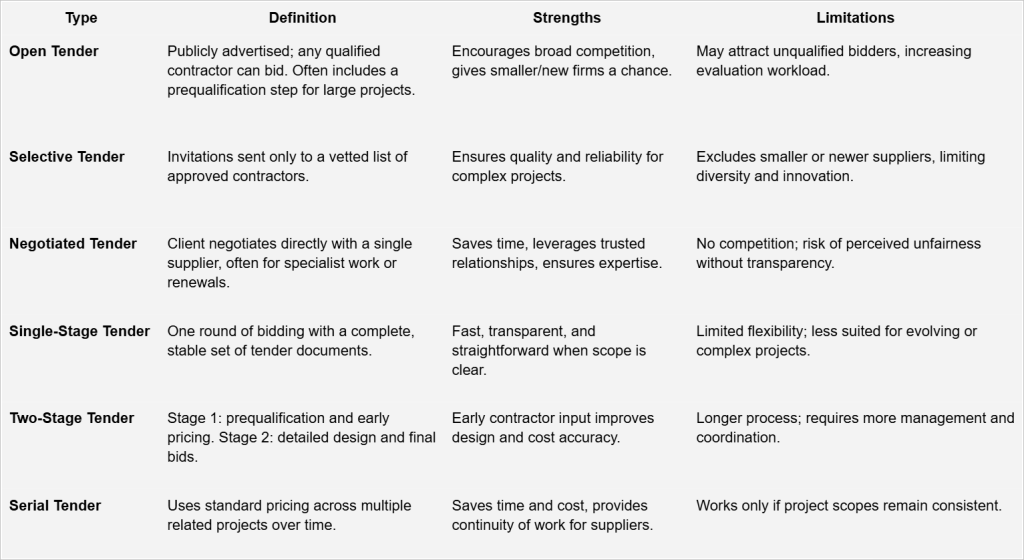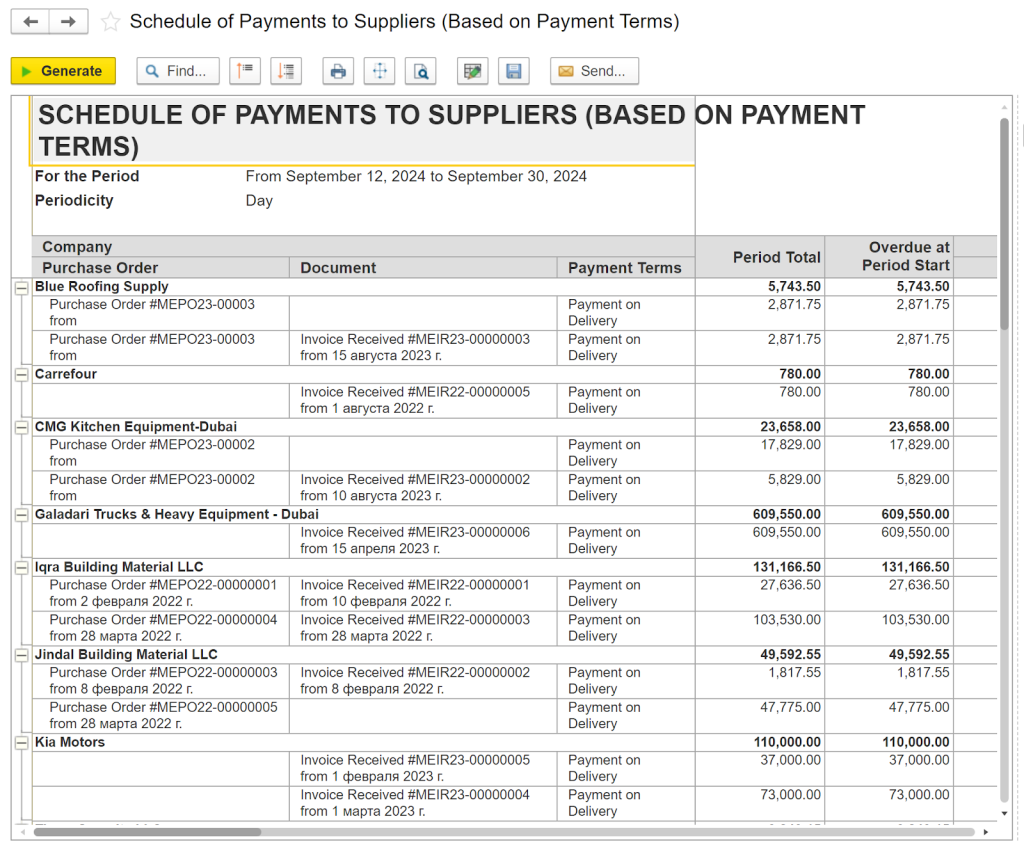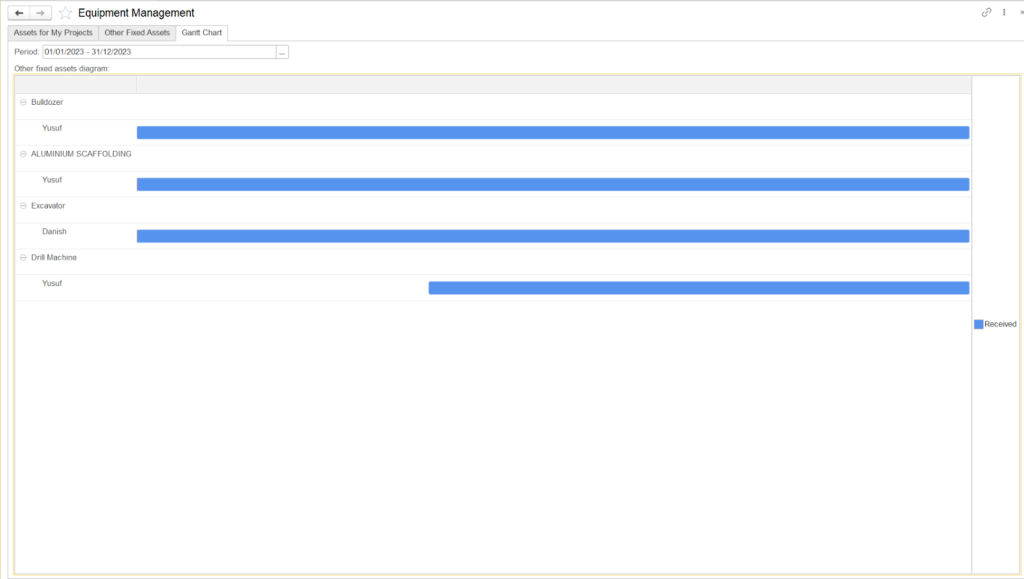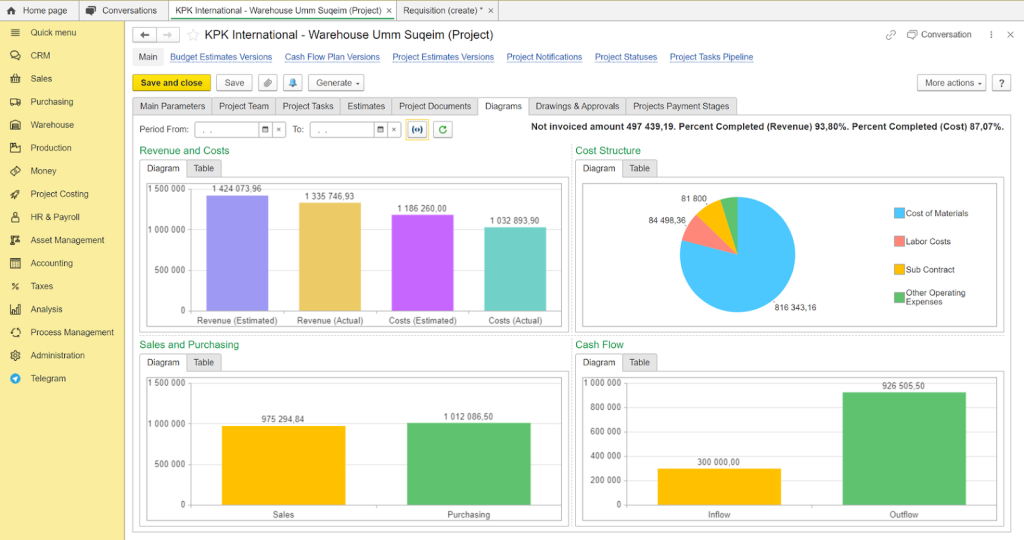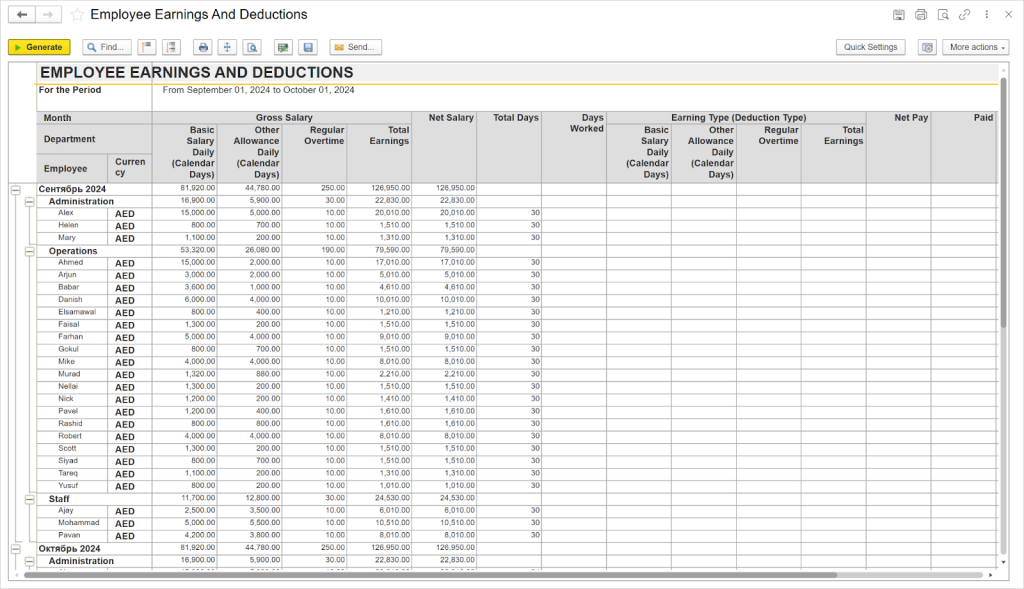Managing tenders is one of the most challenging aspects of construction projects. A single unclear document or rushed decision can result in weeks of delays, disputes, or budget overruns. When done well, however, tendering protects fairness, keeps costs realistic, and helps clients find contractors who can actually deliver.
In the UAE, this process carries even more weight. Mega-projects involve multiple contractors, strict compliance requirements, and high public visibility, making clear tendering procedures essential for keeping work on track and transparent.
This article explains how the tendering process works in construction, why it matters in the UAE context, and outlines practical steps clients and contractors can take to make it smoother and avoid common mistakes.
What Is a Construction Tender
A tender is a formal, written procurement document that sets out the project details, scope of work, and the contractual framework. It is published to attract bids from qualified contractors and suppliers, and clients may also invite eligible bidders directly.
A construction tender refers to
a competitive bidding process by qualified suppliers for defined contracts that cover construction work and related goods or services. It begins with an invitation to tender and ends with the award of contracts to bidders, with tenders detailing materials, costs, and timelines.
With growing project complexity, tenders are used to source diverse goods and services, and construction management arrangements can bring in several contractors to manage the project.
Purpose of Tendering in Construction
The primary objective of the tendering process is to secure best value by inviting bids from multiple suppliers. Open competition expands the range of options and helps identify the most cost-effective solution.
Main Components of a Construction Tender
Under UAE law, tender documentation is a structured process that aligns pricing, bidding, and delivery. Each component plays a specific role in defining scope, expectations, and compliance.
Scope and Boundaries
Every tender starts with the scope of work and its limits. This explains what’s to be built (structure, MEP, finishes, landscaping) and ties it to official drawings, tolerances, and interfaces with other trades.
Deliverables and Pricing
The tender documents specify what bidders are required to submit, such as method statements, schedules, commissioning plans, and
a BOQ, which details materials and works. Measurement rules specific to the UAE and 5% VAT must be taken into account when determining pricing.
Submission and Evaluation
Rules set the deadline, formats, and compliance documents. Evaluation criteria cover not just price but also technical adequacy, schedule, safety, and UAE experience, with local content sometimes affecting scores.
Contract Terms and Conditions
Most UAE projects
use FIDIC-based contracts. Terms address payments, change control, risk allocation, insurance, and dispute resolution (usually DIAC, DIFC-LCIA, or UAE courts under UAE law).
Types of Construction Tenders
Different projects call for different procurement paths with their own strengths and limitations.
Here are the main tender types in the UAE and when contractors might choose each.
Open Tender
Open tenders are widely used in government projects across the UAE, particularly in infrastructure, where transparency and equal opportunity are legal priorities. While they encourage competition, they also increase evaluation workloads as bids can come from a very broad pool.
When to use it
A new public road project in Abu Dhabi is advertised on a government tendering portal. Any qualified local or international contractor can submit a bid. This is ideal for companies wanting to enter the UAE market or compete for government-led work.
Selective Tender
Selective tendering is the preferred route for many private developers in the UAE. By working with prequalified suppliers, clients gain more certainty over delivery, but the approach can narrow the field, which sometimes limits innovation.
When to use it
A Dubai developer building a luxury high-rise sends invitations only to contractors with proven experience in similar towers. A firm on that prequalification list has a higher chance of winning work.
Negotiated Tender
Negotiated tenders are rare but often chosen when projects demand highly specialized expertise, such as advanced MEP systems or unique facade works. They can save time, but must be documented carefully to avoid transparency concerns.
When to use it
A government hospital needs an advanced HVAC system. It directly negotiates with a contractor known for medical facility work rather than running a full tender.
Single-Stage vs. Two-Stage Tenders
Single-stage tenders remain the norm for straightforward projects with well-defined scopes. Two-stage tenders, however, are gaining traction in
the UAE mega-projects because they allow early contractor input and reduce cost uncertainty during design development.
When to use it
A warehouse with a complete design goes to a single-stage tender for a quick award. A museum project uses a two-stage tender so contractors can give buildability feedback before final pricing.
Serial Tender
Serial tendering is less common in the UAE but can be efficient for clients delivering multiple similar projects, such as housing developments or standardized facilities. It reduces pricing effort across repeat work, provided the scope stays consistent.
When to use it
A contractor building multiple government schools signs a serial tender. Each new school is priced under the same framework instead of submitting a new bid every time.
Keep every project profitable
Control budgets with FirstBit ERP
Request a demo
Benefits of a Tender in Construction
While tendering can sometimes be seen as a formal requirement, in practice, it shapes how projects are priced, awarded, and delivered.
Here, we will look at how the process promotes fairness, drives competition, reduces risks, and ensures accountability in construction projects.
Promoting Fairness
A properly structured tender process ensures all qualified contractors have an equal shot at winning the work. By requiring formal bids and applying consistent evaluation criteria, organizations reduce bias and favoritism. Every submission is judged against the same standards, leading to fairer outcomes.
Encouraging Competition
Inviting multiple contractors creates a competitive environment that delivers better value. This promotes sharper pricing and often drives bidders to propose more innovative solutions to stand out. In open tendering, a broader pool of participants can uncover new and more cost-effective approaches.
Minimizing Risks
Clearly defined tender documents, such as covering scope, deliverables, timelines, and evaluation criteria, will minimize the chances of disputes over what was required. Transparent comparison of bids reduces ambiguity, helping both parties align before contract signing.
Strengthening Accountability
A tender leaves a documented trail of decisions from submission to selection. This auditability fosters accountability and trust among stakeholders, whether in public or private projects. It also supports any necessary reviews or dispute resolution.
How the Tendering Process Works in Construction
In construction, tendering is not a single event but a sequence of steps that move a project from planning through to contract award. Each stage has a clear purpose in setting expectations, ensuring fairness, and reducing risks for both clients and contractors.
1. Prepare Tender Documents
This stage sets the foundation for the entire tender. It involves preparing detailed specifications, drawings, a bill of quantities, timelines, evaluation criteria, and contract terms. These documents define what the project requires and how it will be measured.
Pro tip
Double-check consistency between the scope, BOQ, and specifications. Even small gaps can confuse bidders and cause delays later, so clarity here is essential.
2. Issue the Invitation
Once the documents are complete, the tender is formally issued — either through public advertisement or by inviting pre-qualified firms. This step opens the competition and defines the submission schedule.
Pro tip
Clearly state eligibility rules and submission requirements. Contractors make stronger bids when they know exactly what is expected and by when.
3. Receive Bids
Contractors prepare and submit their proposals, including technical solutions, prices, delivery schedules, and compliance information. Submissions are valid only if delivered before the deadline.
Pro tip
Set up a structured Q&A period and publish responses to all bidders. This ensures consistent interpretation of the documents and avoids misunderstandings.
4. Evaluate Bids
Bids are assessed against the criteria in the tender documents. Evaluations usually cover price, methodology, technical capacity, resources, and risk management.
Pro tip
Use weighted scoring to balance technical and financial considerations. This keeps the evaluation fair and prevents over-emphasis on the lowest price alone.
5. Select a Winner
The most suitable contractor is chosen, notified, and formally awarded the contract. From this point, the agreement becomes legally binding for project delivery.
Pro tip
Keep a clear record of how the decision was made. Documenting the scoring and evaluation steps helps prevent disputes and maintains transparency.
6. Negotiate Details
Before work starts, final clarifications are agreed. These may include adjustments to timelines, payment schedules, or risk allocations. Once both sides align, the contractor can mobilize resources on site.
Pro tip
Focus negotiations on aligning expectations rather than bargaining down prices. Shared understanding of scope and responsibilities at this stage prevents conflict during execution.
Win more profitable contracts together with FirstBit ERP
Request a demo
How FirstBit Improves Tender Evaluation and Contractor Selection
Technology can make these best practices easier to apply in day-to-day work. Instead of relying on spreadsheets and manual checks, contractors can use integrated tools that bring data, compliance, and reporting into one system. This is where FirstBit ERP supports construction companies during tendering and contractor selection.
1. Centralized Data for Accurate Bids
Using the Project Costing and Estimation module, contractors can store and access project data, including historical costs, resource benchmarks, and BOQ details in one system. This avoids scattered spreadsheets and ensures bids are based on accurate, real-time figures.
2. Automated Cost and Resource Tracking
HR & Payroll,
Inventory, and
Procurement modules calculate labor, equipment, and material costs directly from current records. This makes bid pricing precise and reduces the risk of underestimation or unexpected overruns.
Schedule of payments to suppliers in FirstBit ERP
Equipment tracker in FirstBit ERP
3. Transparent Evaluation Workflows
The reporting and analytics dashboards generate standardized technical and financial reports. These highlight project capacity, resource allocation, and financial stability, presenting contractors’ strengths clearly to evaluators.
Costing analysis in FirstBit ERP
4. Compliance and Documentation Control
FirstBit automates the preparation of supporting documents such as financial statements, WPS-compliant payroll data, and certifications. This helps contractors meet regulatory requirements and respond faster during prequalification or evaluation.
Employee earnings and deductions in FirstBit ERP
F.A.Q.
1. Why does tendering matter beyond just choosing a contractor?
Tendering doesn’t only decide who builds a project — it shapes cost certainty, timelines, and even trust between all parties. A clear and competitive tender process makes it easier to control budgets, reduce disputes, and prove accountability if issues arise later.
2. What makes up a strong tender package in practice?
A solid package includes more than technical documents. It combines drawings, specifications, and BOQs with practical details like timelines, compliance requirements, and evaluation rules. This completeness gives contractors the confidence to price accurately and protects the client from scope changes or claims down the line.
3. Who actually prepares a tender, and why does it matter?
While the client owns the process, preparation usually involves a team: consultants draft specifications, cost engineers shape the BOQ, and legal experts refine contract terms. If any piece is missing or rushed, the whole tender suffers. That’s why clients who invest in expert preparation often see smoother bidding and fewer disputes during execution.
Achieve peak productivity on site
Manage teams, equipment, and materials in FirstBit
Request a demo
Anna Fischer
Construction Content Writer
Anna has background in IT companies and has written numerous articles on technology topics.




